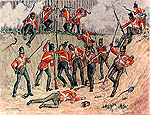When this attack failed, the British and Natives then attacked Fort Stephenson, further down the river. This attack also failed. Procter had to retreat to Amherstburg in defeat.

The attack on Fort Stevenson
General Harrison was building a fort for his army at the rapids of the Miami River. He called it Fort Meigs in honour of the governor of Ohio.
Procter wanted to attack the fort, but he delayed because he hoped for more supplies and troops to be sent to Amherstburg. The weather was also very wet, meaning that the attackers had to struggle through the mud.
Tecumseh also asked for a delay, so that more Natives could join the attack.
The British attacked Fort Meigs on May 1, 1813. By this time, the Americans had managed to finish the fort. The British guns were unable to break through the walls. On May 5th, a group of Kentucky militia who were coming to join Harrison attacked. The British and their allies managed to capture or kill a large number of these militiamen, although some managed to reach the fort.
After the battle, Procter found that the Natives were leaving to go back to their families. The militia also wanted to return home to plant crops for the summer. Knowing that he could not continue the siege, Procter withdrew on May 8th and led the British forces back to
Amherstburg.
See more: Norton's account of the attack on Fort
Meigs, May 1813.
See a video: of a reenactment
of a battle ![]()
(See the
transcription)